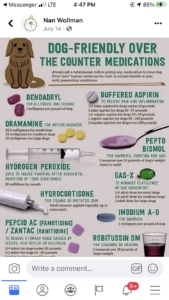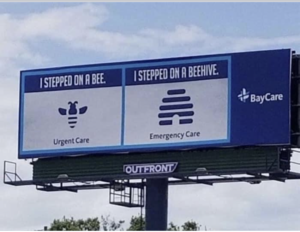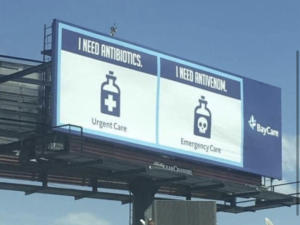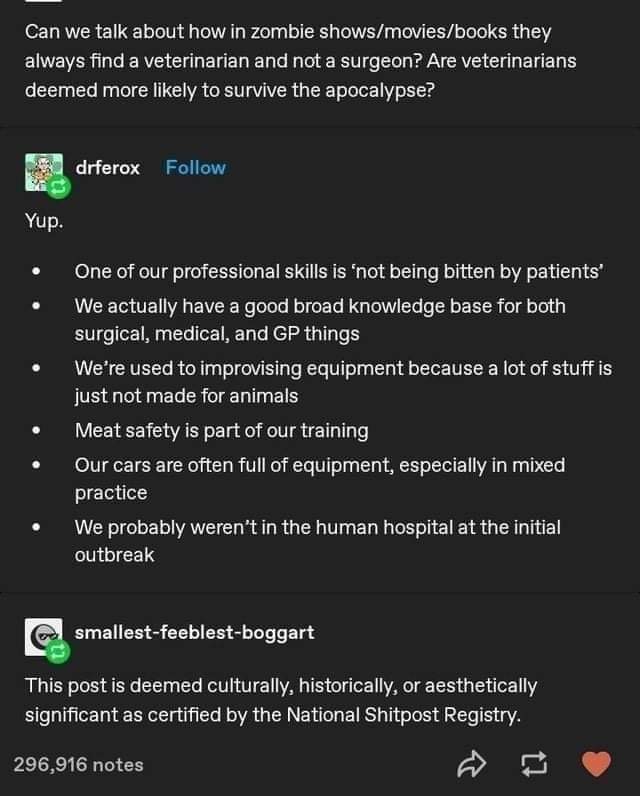How to stay out of the (animal) ER on Xmas
| January 4, 2022 | Posted by Melinda under Uncategorized |
…Or really, any holiday.
Keep the treats out of reach.
Chocolate, raisins, alcohol, edibles. These may be the shining stars of the season for however you choose to celebrate the holidays, but they are not going to end well for Fido and Fluffy.
I know it’s busy and stressful. This is the time of year that things get a little crazy and you get a little forgetful. You baked the oatmeal cookies and set them on the counter to cool and then took your eyes off of them for two seconds while you got the mail. Your housekeeper left you chocolates on the counter while you weren’t there. The bag of chocolate chips was in the grocery bag you were unloading from the car before you put them away. The neighbor kids came over and ate edibles in the back yard and dropped some (it’s **always** the neighbor kids…..).
It sucks to have counter-surfing-hoover-vaccum dog. I have one that has only gotten worse as she has gotten older. In her old age wisdom she has learned that I will not actually kill her for infractions so she has concluded that with actual death off the table, the potential of a reward is worth it. Even if she only gets a reward a fraction of the time. IT SUCKS.
If you want to avoid a visit to the ER and a pricey bill, and you have a pet that you know “eats everything” then take precautions. Maybe that’s putting treats WAY out of reach. Maybe it’s putting Fido and Fluffy in a kennel if not directly in your presence. Maybe it’s keeping them on a leash attached to you if you have guests in the house.
If you have an angel of a dog that doesn’t see food opportunities every time you turn your back, congratulations!!!! Don’t throw that gift away and give them ham and “special” treats. Just stop it. Pancreatitis and gastroenteritis will not make your holidays jolly.
Remember what happened when your toddler snuck the m&ms into their bedroom that one night, ate them all, and then puked multi-colored confetti every where in their bedding? That’s practically heaven compared to the copious amounts of diarrhea, vomiting, and potentially life-threatening complications that Fido is going to get just because you couldn’t ignore some big blinking pleading eyes. At the very least, even if Fluffy doesn’t have pancreatitis due to dietary indiscretion, there’s probably going to be a big bill for bloodwork and imaging to rule out the various nasty possibilities and conclude that it is “just” gastroenteritis…for now.
Stop self-medicating.
You know all those charts that list “safe” human medications to give your pet?
Don’t do it.

no I’m not blowing this up bigger to make it more accessible. There’s only like….2 things?…on this list that doesn’t require a bunch of informed caveats of potential downsides.
Sure, sometimes we use those medications.
Most of them have caveats associated with them.
You need to know the downsides of a medication before deciding to use it. Being informed means knowing….
- the correct dose for the weight of the animal and their species.
- the risks of using the drug even at the correct dosages.
- knowing which conditions that the drug can make worse and being reasonably sure the animal isn’t suffering from one of those diseases.
- which other medications cannot be used with this medication. Knowing how likely it is that your diagnosis is wrong and one of those other medications will be needed in the near future.
- knowing what additives are commonly in human meds that may be toxic to other species.
I’m not trying to be snarky. It’s not like just by the virtue of being a vet that I have some sort of special bank of knowledge that I refuse to share with you, just to force you to come to the clinic so I can charge you money.
No, it’s because nothing, let me repeat – NOTHING -, is totally benign and everything has consequences in medicine.
Medicine is more than matching symptoms with an algorithm that spits out a disease, which in turn gives you a list of medications to cure or control it. That’s the most visible end result, but that isn’t where the work is. That’s not what you are paying me for.
You brought me your female golden doodle for vomiting and diarrhea. She has a history of eating some sort of table scrap. You know it’s just a tummy ache due to all that rich food and really all she needs is some fluids, anti-nausea medication, maybe a probiotic, and a bland diet.
You are right. Gastroenteritis secondary to dietary indiscretion is probably the diagnosis we will arrive at, and the you are probably spot on with the treatment. But here I am strongly recommended bloodwork, imaging, and a bunch of other things that cost a bunch of money. AND ON A HOLIDAY. That unfeeling money-hungry b*tch.
But.
What you are paying me for is to know that Addison’s disease is over-represented in female poodles and also presents like gastroenteritis. And if we just treat for gastroenteritis and “wait and see” you dog may be dead in 24 hours.
You are paying me because even though you’ve seen 20 of these cases in your long history of pet ownership, I’ve seen over 500 in the last year and I know that sometimes it’s PLE. Or HGE. Or a foreign body. Or cancer. Or parasites. Or liver disease. Or a toxin. Or an endocrinopathy. And sometimes they look exactly like your dog.
You are paying me to create a likely list of differentials (all the possibilities that could explain the problems in front of us) and then rank them from most to least likely, and then plot that against which ones need to be ruled out ASAP because even though they aren’t the most likely, we won’t have a second chance to to catch and cure, against other differentials we can rule out later if patient doesn’t improve on treatment.
The reason this career takes so much education is because of all the depth and breadth of knowledge that is required on the back end.
The problem is that most of this process is invisible.
The visible culmination of all this thought and consideration is that in the end….usually… if it walks/talks/looks like a duck…it’s a duck. But sometimes it’s a very small deformed goose and sometimes if I treat it like a duck, I will kill your pet.
You are probably smart enough figure out what is wrong with your pet and medicate appropriately and be fine most of the time. But, I have a doctorate degree in the subject of medicine and I’ve been practicing this subject as my full time job in which I am personally liable for my mistakes in the state I practice for the last 7 years and I still get it wrong sometimes.
Activated charcoal. Did you look up whether it works against the toxin you believe your dog ate? Couldn’t hurt right? Except….Did you consider the risk of hypernatremia after administration? Even something as simple as charcoal is a risk-benefit equation. The risk is only worth it if the charcoal has a good chance of giving you some benefit because otherwise when your dog is the one that ends up with seizures and badness from charcoal, when the charcoal wasn’t needed in the first place, that’s not going to feel good. There’s also a good chance that the charcoal will only be partially effective….monitoring bloodwork and treating any “escaped” toxin effects early may be the difference between picking out a color for a paw print, and getting another Christmas. (and follow up with bloodwork . This is why I won’t sell it to you over the counter sir, even though you are yelling at me from the parking lot. It’s not going to fix all your problems and probably cause you some other headaches.
I’ve had to amputate limbs that the owners have bandaged wrong. Horse people!!!! Do you know the very important difference between bandaging a small animal versus a horse?????? Species differences are for REAL. All. The. Way. To. The. Toes.
Sure, Tylenol is sometimes used in dogs….but giving a “small piece of pill” because your dog “is small” is still probably going to be an overdose (Yes, you have to do the mg/kg to pill/animal math!!!!!).
And then I’ll have to treat your pet for acetaminophen toxicity in addition to whatever injury it has that was not magically fixed with tylenol (yeah, that broken leg probably needs more than an NSAID).
“Don’t worry!” you say, “I gave it children’s liquid form!” Great. Did you make sure it didn’t have xylitol? Also poisonous to dogs?
Even at the correct dosage you may have completely screwed up our ability to give your pet something more appropriate for its pain because NSAIDs need wash-out periods between them to minimize serious side effects. Unlike humans, you can’t stack different types of NSAIDs in dogs without risking frying their GI tract and various life-important organs.
What if it’s actually some disease that needs a steroid? Giving a steroid medication too soon after an NSAID (let’s say…within 1-2 weeks) has a really real risk of bleeding painful possible life-threatening gastric ulcers.
Did you remember that Tylenol should never be given to cats?
Were you aware that Benadryl can cause hyper excitability before you gave it to make it sleep before your 8 hour car trip and it turned into a pingpong ball?
Did you weigh the risk and benefit of making them puke sooner with hydrogen peroxide (and risking some esophagitis) against the risk of delaying emesis long enough to find a vet and using the apomorphine option (a drug that almost always makes dogs puke)? Did you consider that you had a brachycephalic dog and the risk of aspiration pneumonia with induced vomiting?
You get the point.
Here’s the most important thing to remember. NOTHING is benign. Nothing. Everything is risk-benefit calculation. Recommendations change over time. The specific circumstances around a specific situation can change the treatment.
It’s fine to use some common sense and do some home treatment. To get some advice from a person who has been around the block a time or two.
But, just remember that nothing is benign. If you can’t think of both the pro and the con of doing something, you probably need to do a little more research before you do it, otherwise you may be one of those people in my ER who is stunned to discover that they have turned something relatively simple into something that now requires multiple days of ICU care for a small chance of survival (with a big bill).
Play-dates and Sleep-overs are a bad idea.
Stop bringing your pets with you to other people’s houses that also have pets. Or allowing your friends and family to bring their pets. It’s not going to be a big happy family. And unlike yelling at your uncle at the food table, your furry pets have claws and teeth to settle their arguments.
Some dogs are perpetual puppies and do seem to exhibit the juvenile behavior of “I like to play with strangers outside of my pod” for their entire lives.
Great. Congrats.
That’s actually not normal animal behavior.
When we domesticate things, we often select for extended juvenile periods, or juvenile behavior traits expressed even as adults.
Being able to nicely play with other adult dogs that are not part of their “pack” is an example of this.
For lots of dogs this is not part of their personality.
For lots of dogs having another adult dog in its house is extremely stressful.
Most bites and fights come from stress and anxiety.
Even if you are an expert in introducing dogs and integrating everyone into a one big happy family, the holidays are not the time.
The holiday season is chaotic. Not only are there strange dogs, those dogs usually come with strange people. There are lights, and noises, and people, and a disruption to routine.
This. is. not. the. time.
The shocked “But he’s never done that before!” is the most common thing I hear from clients during the holidays.
Kennels and kennel training. Having conversations with friends and relatives before they show up with their pets at your door for and extended holiday. Having a plan and a little bit of imagination of what could happen will go a long ways towards preventing it.
Don’t put it off.
Don’t ignore the worsening signs of the chronic disease until…Xmas morning….New Years….Thanksgiving day. Take care of that sh*t when it happens.
If your CHF dog’s respiration rate has been increased since five days ago, and he hasn’t eaten in three days, it isn’t going to fix itself just because it’s xmas week. PLEASE don’t wait until xmas to have your dog seen if you don’t want to have to make hard decisions on Xmas. Xmas is not a magical day where bad stuff doesn’t happen. It was going to be hard no matter what, but now you are asking me whether I can do anything to delay the inevitable until tomorrow or the next day because you don’t want every Xmas to be the anniversary of his death, and no. No I cannot.
Sometimes treatment can wait. Sometimes it can’t. If your cat is diagnosed as a diabetic the week of Xmas and you decide not to treat because “It’s Xmas and money is tight”…..I promise it will be even MORE money to fix (with a worse prognosis) when you wait for three days and now it’s on the DAY of Xmas and the cat is in DKA.
Spay your female dog.
The difference between a spay and a pyometra:
- You schedule the spay on your own time; A pyometra cannot be rescheduled to a more convenient time.
- If unexpected financial hardship occurs, you can reschedule a spay: A pyometra does not wait for your checking account.
- A spay usually costs a couple hundred dollars; A pyometra is typically $1k-3k.
- A routine spay rarely results in death; I’ve had pyometra’s die on the exam room floor
- An elective spay is not a Christmas Emergency; A pyometra doesn’t care that you are out of town and that it’s Christmas.
- If money is tight, there is low cost options to get a dog spay done; you may or may not find a low-cost clinic that will do your pyo for cheaper than the ER just quoted you on a “regular day”. I guarantee that you will not find a low-cost clinic on Christmas day that will do it for you.
If you don’t know what a pyometra is, please spay your dog.
If you do not have at least a thousand dollars in your checking account or available on a credit card for a pyometra surgery, please spay your dog.
When the clinic says “this is not an emergency,” stay home.
We do a lot of triage over the phone.
Most of the time we say “come in” because it’s hard to know exactly what an owner is seeing or interpreting and it’s better to be safe than sorry.
What this means….is that if we say “this can wait” then we are pretty dang sure it can wait.
For example.
The puppy you’ve had for three days.
You saw moving white things in its poop.
You are pretty sure they are worms.
We are pretty sure they are worms.
Worms are not an emergency. Bringing your new under vaccinated puppy to the ER because you are freaked out about worms means a long wait and potential infectious disease exposure (because we ARE telling the bloody vomiting-diarrhea-probably-parvo-puppies to come in).
Because worms aren’t an emergency, maybe I have the stuff to do a fecal float and maybe I don’t. Maybe I have 3 or 4 different dewormers at this clinic and can choose the most appropriate one, and sometimes the dewormer you get is the only one this urgent care stocks and isn’t my ideal choice.
You are going to pay more, potentially get worse care, and clog up the line for a really critical patient (except most of the time I won’t even see you until I can squeeze you in without compromising something that is actually sick, no matter how many times you call reception remind us you are still in the parking lot. Which means an 8+ hour wait in today’s ER craziness).



















